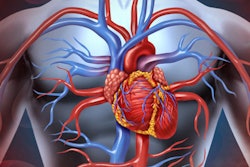
An increase in pericoronary adipose tissue (PCAT) attenuation -- a biomarker associated with inflammation -- on coronary CT angiography (CCTA) scans was associated with vulnerable plaques and may help predict the risk of heart disease, according to an article published online July 18 in JAMA Cardiology.
The noninvasive detection of high-risk coronary plaques with standard imaging tests such as cardiac MRI, SPECT, and echocardiography remains a challenge in clinical practice, wrote first author Dr. Marcus Goeller and colleagues from Cedars-Sinai Medical Center in Los Angeles and Friedrich-Alexander University Erlangen-Nürnberg in Germany.
Recent research has shown that measuring changes in the amount of fat surrounding heart vessels on CCTA scans can provide insight into the degree of coronary inflammation, they noted. Ultimately, this information could help identify high-risk, or vulnerable, plaques in individuals and, in turn, predict their risk of developing heart disease.
To explore this possibility, Goeller and colleagues examined CCTA data from 19 patients with acute coronary syndrome and 16 with stable coronary artery disease. They used semiautomated software (AutoPlaque, Cedars-Sinai Medical Center) to characterize coronary plaques and measure PCAT attenuation on the CCTA scans.
There were statistically significant increases in two plaque features -- low- and intermediate-attenuation noncalcified plaque burden -- as well as in PCAT attenuation for vulnerable plaques compared with nonvulnerable plaques, they found. Furthermore, each of these risk factors was independently associated with the presence of vulnerable plaques (p < 0.05).
| Comparison of risk factors for plaques on CCTA | ||
| Nonvulnerable plaque | Vulnerable plaque | |
| Low-attenuation noncalcified plaque burden | 3.6% | 12.6% |
| Intermediate-attenuation noncalcified plaque burden | 19.4% | 38.4% |
| PCAT attenuation | -74.8 Hounsfield units | -69.1 Hounsfield units |
| Frequency of increased PCAT attenuation | 15.7% | 47.8% |
"Pericoronary adipose tissue CT attenuation, a novel surrogate biomarker of coronary inflammation derived from routine CCTA, in combination with high-risk plaque features, can potentially identify vulnerable plaques and may be a valuable tool to guide future prevention strategies," the authors wrote.
These findings present PCAT attenuation on CCTA as a possible alternative for predicting the risk of heart disease caused by vulnerable plaques, wrote Dr. Rory Hachamovitch and Dr. Venu Menon in an accompanying commentary. Yet demonstrating its clinical and cost effectiveness over current diagnostic methods that do not involve radiation and contrast exposure, such as a troponin test, may prove difficult.
"Nonetheless, it appears that the CT identification of culprit lesions is within our sights," they wrote. "The possible value of CCTA in this setting may be in patients whose diagnosis remains ambiguous despite serial biomarker tests."




















